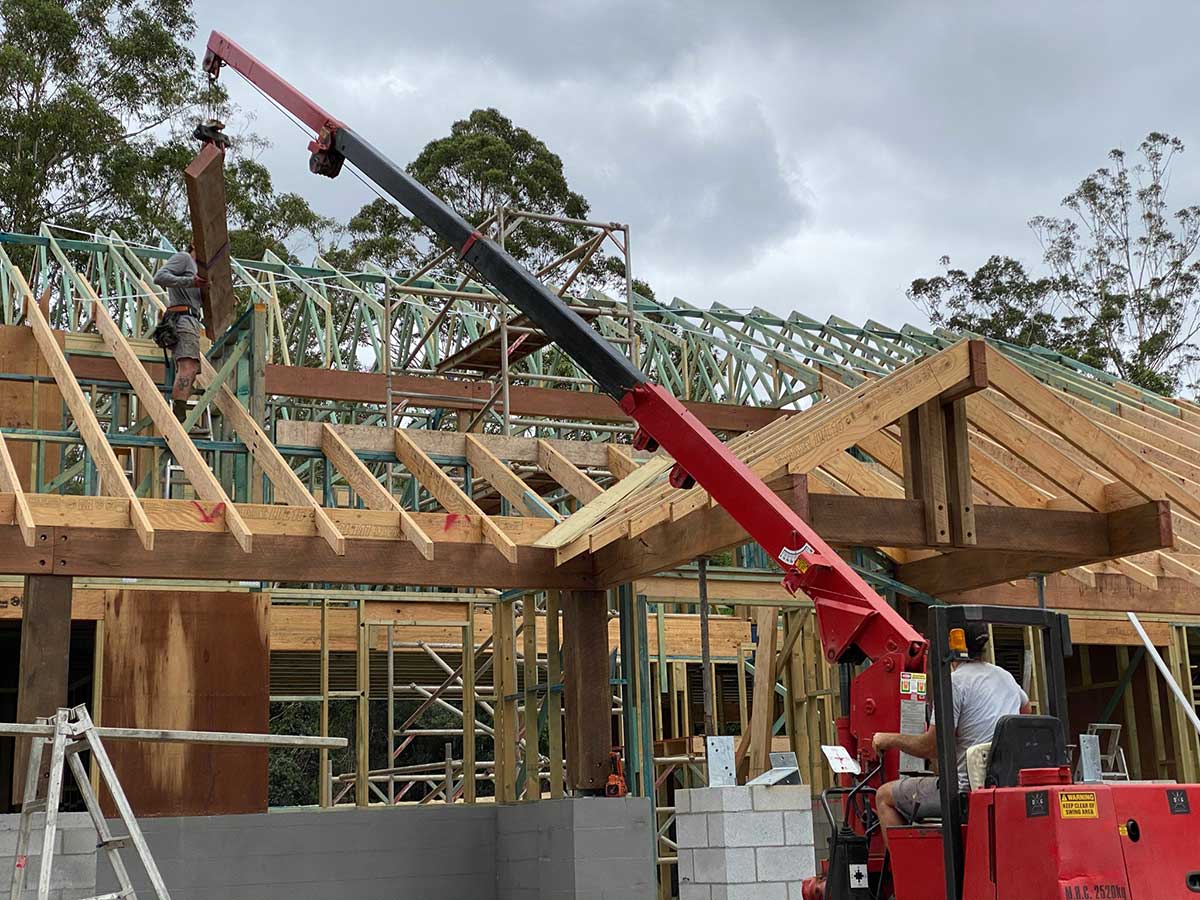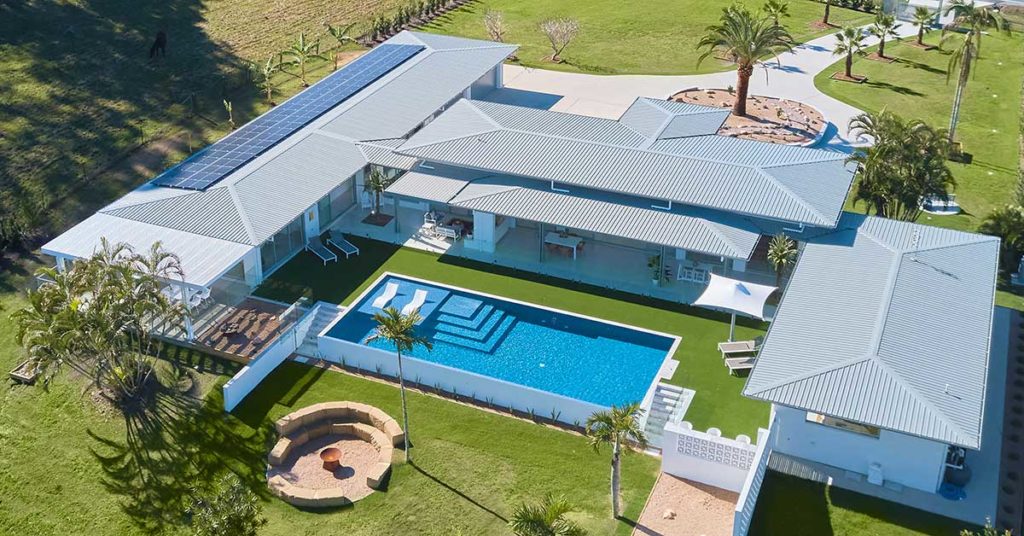For bespoke design projects it is highly recommended you engage an Architect who will not only deliver you with a design that meets your functional and aesthetic needs, but just as importantly, a design that meets your budget.
Unfortunately, by its very definition, bespoke design is unique and will comprise numerous variables that impact the construction price including the following;
Construction methodology
The main two factors contributing to building cost are materials and labour.
To a large degree residential construction methods and building materials have changed very little for centuries, and as such builders have become comfortable with the costs associated with them, so can estimate building prices fairly accurately.
Unfortunately, if new building systems or unusual materials such as CLT are proposed as alternatives to conventional construction they tend to be more expensive, despite the fact that may offer obvious benefits such as reduced building time.
This may be due to increased costs as a result of supply and demand, reduced competition because many builders are reluctant to change the status quo, or uncertainty about potential issues that could arise during construction resulting in increased material or labour costs.
Anyone who has visited a building site will immediately notice the large amount of waste that fills skip bins that need to be emptied on a regular basis throughout the construction process. These wasted materials have all been paid for by the client, so reducing or eliminating this waste should also reduce the building cost. This is one of the reasons modularisation and prefabrication are integral to sustainable building practices in the future.
Whilst the builder or tradesmen are responsible for estimating the materials they need for any job, design plays an important role. Most materials or components are produced in standard sizes, so designing within the parameters of these sizes not only reduces waste, but also ensures economy in cost.
Most builders are trained as carpenters which provides them with a wide range of construction skills enabling them to build a large proportion of any home without the need to engage other specialist trades. The more unusual the materials or services adopted in a design, the greater likelihood that specialist trades will be required. The more trades required on site, the more expensive the construction is likely to be.
Traditional construction systems also vary considerably in price as a result of differences between material, labour and installation costs. As an example, lightweight materials that can be handled manually on site are generally cheaper and easier to install than heavier components which require heavy lifting equipment or machinery.
To reduce material and labour costs the following are some design principles that should be considered;
- Building on a sloping site is more expensive than a flat site.
- A simple building footprint is cheaper than a highly articulated building form.
- Single storey is cheaper than multi-level construction.
- Ceiling heights based on plasterboard sheet widths minimise costs and waste.
- Wet areas and joinery are big cost items.
- Lightweight construction is cheaper than masonry construction.
- A suspended timber floor is cheaper than a suspended concrete floor.
- Horizontal sliding windows are the cheapest openable window option.
- Choose standard size windows and doors.
- Grouping wet areas together reduces plumbing and drainage costs.
- Align loadbearing walls where possible in multilevel buildings.
- Avoid excessive spans / room sizes where possible.
- Timber structural members are cheaper than steel.

Preliminaries
There are also other less obvious costs associated with building that need to be considered.
Preliminaries (Prelims) are time related site costs that are directly related to the running of the project but which are not accounted for under labour or material.
They are the cost of the site-specific overheads for any given project and include items such as;
- Welfare provision for on-site staff – temporary toilets and other facilities.
- Connection of temporary utilities such as power and water.
- Equipment and machinery hire including items such as security fencing, scaffolding, security, digging or lifting equipment.
- Rubbish disposal including skips and end of project building / site clean.
- Personnel costs for staff working on the project such as a site foreman.
Typically larger construction companies have higher preliminary costs than smaller “hands on” builders who don’t need to employ additional staff to manage their projects.
Overheads, Profit and Margin.
There are further costs that make up the final building price:
Overheads (different to preliminaries) relate primarily to the costs of running the building company including office rent, office expenses, office staff, licenses, insurances, accounting, and legal fees.
Profits are self-explanatory, and every business relies on making them to survive.
Margin is either a lump sum fee or a percentage applied to the estimated cost of performing the work which includes allowances for overheads, risk and profit. The margin is often not disclosed but is built into the overall cost, and typically varies from 10% to 20%.
As with preliminaries, larger building companies will need to operate on a higher margin to cover their overheads and risks.
Cost Planning.
Understanding the many variables that influence the cost of building is important when designing to a budget. However only after estimating the cost of the design will you know if you can build within the budget allocated.
The sooner this can be done the better.
For new buildings, applying construction rates (cost per square metre) to the building area can be a useful starting point. These rates will be based on similar projects completed in the past; however every custom designed project is different, and market conditions vary over time.
Consequently, they should only ever be used as a preliminary guide, and in some cases like renovations, may not be applicable at all.
That is because renovations typically comprise numerous hard to quantify costs. There are “lost” costs for demolition work, nil cost for retention of existing built structure, increased costs for building within the constraints of existing structure, and repair costs associated with unforeseen latent conditions.
So how do you establish a building cost?
Whilst Architects are skilled professionals, they are not trained as building estimators or cost planners. Comparable to undergoing surgery, as a patient you would need to engage an Anaesthetist to prepare you for surgery, and then a Surgeon to undertake the operation. You may have the choice to forgo the anaesthetic, but the consequences could be dire.
Similarly with designing a new home, if your budget is critical, then you are well advised to engage a specialist cost planner to perform this role early in the process to avoid future pain.
There are a number of cost planning options you can consider.
Specialist Cost Planners or Quantity Surveyors are trained to perform this role. They will use the design drawings to measure quantities of materials, apply labour rates for the respective trades, calculate preliminaries, and include a margin based on existing market conditions.
Builders either engage Cost Planners to establish their building quotes or have the requisite skills to do it themselves.
That provides another option. You engage directly with a builder to provide this cost planning service for an agreed fee. Once the cost plan is completed, you can either elect to proceed with the builder to contract or choose to tender the project to other builders with the knowledge that you have one price already confirmed. Not all builders will accept this arrangement, but many will, reliant on building the trust required to win the job during the cost planning process.
Having a cost planner involved early in the project allows you to make informed design decisions throughout the various design stages, and to avoid the disappointment of discovering at the end of this often-lengthy process that you cannot afford to build what’s been designed and documented.
At LDS we’ve been involved in designing a wide range of residential dwellings, from economical flatpack emergency disaster relief shelters, to multimillion dollar mansions, so we understand the importance of designing to a budget. We can design you a Taj Mahal if budget permits, however there is little point if the budget only allows you to build the foundations.
There is considerable time, emotional, and financial capital expended on designing a new home, so, do it right, do it once, and you will end up with a great result.
You might also be interested in...
The Most Popular Home Configurations in Australia in 2024
Discover 2024’s top Australian home configurations: bedrooms, bathrooms, and parking preferences. Explore how changing lifestyles shape popular house configurations nationwide.
Exploring Contemporary Applications of Brise Soleil
Contemporary applications of Brise Soleil combine functionality, aesthetics, and sustainability, making them a popular choice in various building designs worldwide.
